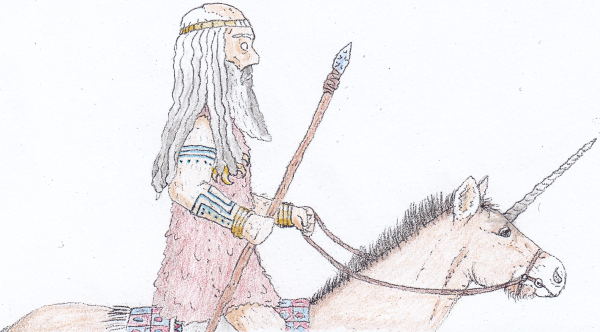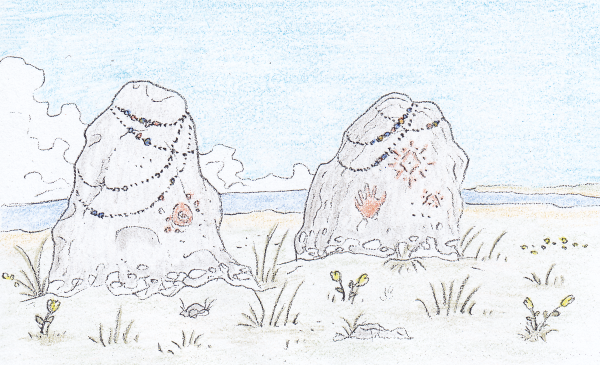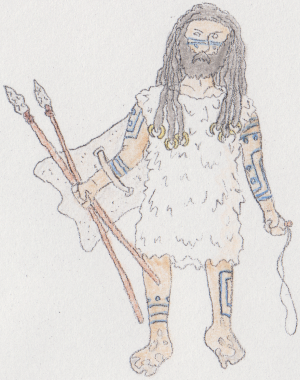Dardians
Dardic: Dardol
The dardians1 are natives of Darden (dard: Túffek Vó), a coastal plain between Nótal Bay to the west and the Kingdom of Faron to the east, south of Goldensands. Three of their tribes also live in Harúnnen province of the Kingdom of Faron. They are humans with a distant elven ancestry, relatives of the Faronians, Amrans and Rómúkans.
Their relationship with the Faronians has historically been mixed, some tribes have a history of raiding remote farmsteads and villages, others prefer more peaceful methods of acquiring food, cloth and other goods, and a few tribes have even settled within the Kingdom of Faron and taken up sedentary lifestyle.
Nose piercing is widely practiced and bracelets are popular, and married women wear special bracelets adorned with numerous tiny gold cones, which jingle with the slightest movement. Long necklaces, adorned with dyed beads made of wood, bone and metal are often worn specifically to be placed on the owners' gravestone.
The hair is usually divided into dreadlocks, often with crescent-shaped gold jewelry hanging from some dreads as talismans. Chiefs of southern tribes sometimes braid their beard as well.
The meat of lions is ritually consumed by chiefs and warriors after a successful hunt, some of it is dried and nibbled on before battle in belief that it will give warriors a lions' ferocity.
The most common drink is wine from Faron or, more rarely, millet beer from Gysikan.
The main ritual in a dardians' life is their coming-of-age ceremony, where they receive tattoos made with powdered lapis lazuli.
The camp then holds a feast during the evening, often with fire lit directly above the grave to give the spirit of the dead essence of the food and drink that's consumed in their honour. The morning after, necklaces are placed on the standing stone before the tribe moves on.
Ancestor worship is an important part of dardian beliefs, and its not uncommon to sleep by a grave in hopes that the ancestors give good advice in the dreams.
In some traditions, a person reincarnates as a snake, as their shedding of old skin is associated with immortality, while others claim that they're reborn as lions to challenge their descendants to prove their bravery.
Armour is rarely used, the only defense being shields made of goat skin.
The dardians1 are natives of Darden (dard: Túffek Vó), a coastal plain between Nótal Bay to the west and the Kingdom of Faron to the east, south of Goldensands. Three of their tribes also live in Harúnnen province of the Kingdom of Faron. They are humans with a distant elven ancestry, relatives of the Faronians, Amrans and Rómúkans.
History
Dardian history stretches back to the earliest people who populated SE-Adynía. Around 8000 b.Paþ, when the use of horses and chariots for war had spread from neighboring Faron, the dardians became the first to tame Plains Unicorns found in their homeland. Initially using them for drawing chariots along with mundane horses, dardians have since abandoned this practice in favor of horse-riding, aided by their minimal use of armour throughout history. Aside from unicorns, which are reserved for tribal chiefs, dardians are famed for their exceptionally fast and hardy taffalic horses.Their relationship with the Faronians has historically been mixed, some tribes have a history of raiding remote farmsteads and villages, others prefer more peaceful methods of acquiring food, cloth and other goods, and a few tribes have even settled within the Kingdom of Faron and taken up sedentary lifestyle.
Society
Dardians are made up of nine tribes, of which three live in Faron, and aside from those, most live as nomadic hunter-gatherers, lead by chiefs who alone have the right to capture, tame and ride unicorns. Some tribes are believed to be descended from one of the sons of Dór, the sun god and Tíf, the moon goddess; the Þúffalol tribe, for example, traces its heritage back to the hero Þúffax.Culture
Apparel
Northern dardians tend to wear simple loincloths and cloaks made of goat skin, while the southern tribes -particularly those within Faron- wear linen tunics, preferably white or red.Nose piercing is widely practiced and bracelets are popular, and married women wear special bracelets adorned with numerous tiny gold cones, which jingle with the slightest movement. Long necklaces, adorned with dyed beads made of wood, bone and metal are often worn specifically to be placed on the owners' gravestone.
The hair is usually divided into dreadlocks, often with crescent-shaped gold jewelry hanging from some dreads as talismans. Chiefs of southern tribes sometimes braid their beard as well.
Cuisine
Traditional dardian diet mostly consists of meat (usually wild goats, horses or rabbits), fish from the Únnen river on the Faronic border, and seals, crabs and mollusks along the coast of Nótal Bay. Wild pistachios found in northern Darden are popular, usually roasted and eaten with meat. Bread and goat cheese is mostly eaten by the tribes in Harúnnen.The meat of lions is ritually consumed by chiefs and warriors after a successful hunt, some of it is dried and nibbled on before battle in belief that it will give warriors a lions' ferocity.
The most common drink is wine from Faron or, more rarely, millet beer from Gysikan.
Language
The dardian languages are related to those of the amrans, with some vocabulary from faronic. Only a few tribes are literate, using letters based on the faronic alphabet developed by the tribes in Harúnnen.Religion
Dardians, even those who have adopted sedentary lifestyle, have little interest in building temples, making statues or even erecting altars for their deities. They simply see these things as unnecessary, believing that gods can hear praise just fine, and see offerings wherever they are made.The main ritual in a dardians' life is their coming-of-age ceremony, where they receive tattoos made with powdered lapis lazuli.
Deities
Dór
The sun god, Tif's husband, father of the stars.Múx
The war god, usually described as a man with the head of a lion.Tíf
The moon goddess, Dór's wife, mother of the stars.Zel
A protective goddess.Funerary rites
The dardians practice two kinds of burials depending on the persons' status. Tribal chiefs are embalmed, wrapped in cloth or skins and buried by a standing stone, while the bodies of others are left on a stone slab, and whatever bones remain are later buried by a standing stone as well.The camp then holds a feast during the evening, often with fire lit directly above the grave to give the spirit of the dead essence of the food and drink that's consumed in their honour. The morning after, necklaces are placed on the standing stone before the tribe moves on.
Ancestor worship is an important part of dardian beliefs, and its not uncommon to sleep by a grave in hopes that the ancestors give good advice in the dreams.
In some traditions, a person reincarnates as a snake, as their shedding of old skin is associated with immortality, while others claim that they're reborn as lions to challenge their descendants to prove their bravery.
Warfare
Dardian warriors are known for their ferocity in war, riding on the backs of swift horses and even swifter unicorns, the latter having the additional ability to use air magic from their horns to knock enemies on the ground. Horse trappings include saddle cloths or -for esteemed warriors- lion skins and very simple bridles. Javelins, either tipped with stone or -particularly among the northern tribes- magic crystals, are the main weapons of the dardians along with thrusting spears.Armour is rarely used, the only defense being shields made of goat skin.
1Original icelandic: Dardverjar, singular: Dardverji







Comments